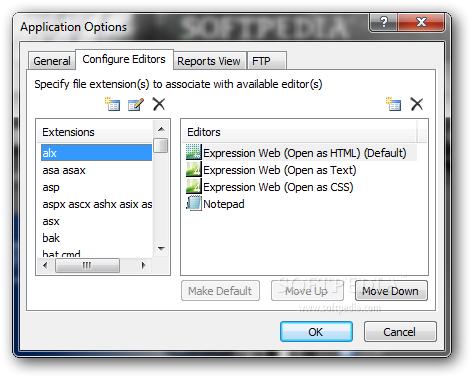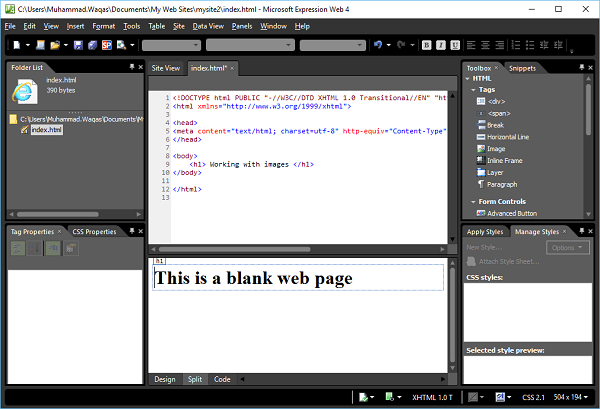

- #Microsoft expression web 4 help mac os x#
- #Microsoft expression web 4 help update#
- #Microsoft expression web 4 help code#
- #Microsoft expression web 4 help license#
- #Microsoft expression web 4 help free#
No new versions of Expression Web or Design are planned.

#Microsoft expression web 4 help free#
Technical support is available for customers who purchased Expression Web or Expression Design following their published support lifetime guides, while no support will be offered to free downloaders. Expression Blend is being integrated into Visual Studio, while Expression Web and Expression Design will now be free products. Availability Īs of December, 2012, Microsoft has announced that Expression Studio will no longer be a stand-alone product.
#Microsoft expression web 4 help license#
Expression Web 4 SP2a, an hotfix released in October 2011, fixes an issue caused by corruption in the license store.
#Microsoft expression web 4 help code#
Expression Web 4 SP2 was released in July 2011, and fixed a number of issues and introduced new features such as jQuery IntelliSense support, a panel for managing snippets, Interactive Snapshot Panel, comment/uncomment functionality in Code View, and workspace and toolbar customization. Expression Web 4 Service Pack 1 was released in March 2011 and added support for IntelliSense for the HTML5 and CSS3 draft specifications in the Code editor, HTML5 and CSS3 support in the CSS Properties palette, selected CSS3 properties in the Style dialogs, semantic HTML5 tags in Design View and new PHP 5.3 functions. Version 4 does not bring back all the features removed in Version 3. Microsoft Expression Web 4 also provides an SEO Checker which analyzes produced web site against the best practices for getting the highest possible search-engine rankings.
#Microsoft expression web 4 help mac os x#
It added the option of HTML add-ins, and access to a web-based SuperPreview functionality, for testing pages on browsers that cannot be installed on the user's system (such as Mac OS X or Linux browsers). Microsoft Expression Web 4 was released on June 7, 2010. Service Pack 3 for Expression Web 3 was released in October 2011 and includes general product, stability, performance, and security fixes. Service Pack 2 for Expression Web 3 was released in April 2010. This feature was added with Expression Web 3 Service Pack 1, released in November 2009. Also noted was the lack of support for root relative links, links that start with a "/" to refer to the root of a web server. Version 3 introduced Expression Web 3 SuperPreview tool for comparing and rendering webpage in various browsers. Other features like Undo do not work reliably. A result of this was features like customizable toolbars and menus, standard Windows color scheme, spell check, DLL addins, file menu export feature, drag-and-drop between remote sites, comparing sites by timestamp, automatic language tagging, basic macro support were removed in this version. With version 3, Expression Web was rewritten in Windows Presentation Foundation, in line with the rest of the Expression Suite, without Microsoft Office dependencies. Until version 2, Expression Web was the only application in the Expression Studio suite based on Microsoft Office code and dependencies. Microsoft Expression Web 3 was released in 2009.
#Microsoft expression web 4 help update#
No service packs were released for version 2, but on December 2008 it received an update that fixed a problem that prevented macros from running on Windows Vista-based client computers. Expression Web 2 offers native support for PHP and Silverlight. Microsoft Expression Web 2 was released in 2008. Expression Web does not have the form validation controls for HTML fields like FrontPage, but supports validator controls for ASP.NET.

The first and only service pack was published in December 2007. The Release To Manufacturing version was made available on December 4, 2006. Beta 1 removed most of the FrontPage-proprietary (non-standard) features such as bots (use of FPSE features for server-side scripting), parts, functions, themes, automatic generation of navigation buttons, FrontPage forms, navigation pane to build a web site's hierarchy, and other non-standard features available in CTP 1. On September 5, 2006, Microsoft released Beta 1. On May 14, 2006, Microsoft released the first Community Technology Preview (CTP) version of Expression Web, code-named Quartz. Included in Microsoft Expression Studio 4 Included in Microsoft Expression Studio 3 Old version, no longer maintained: 3.0 (.0) Included in Microsoft Expression Studio 2

Old version, no longer maintained: 2.0 (.1084) Old version, no longer maintained: 1.0 (.1014)


 0 kommentar(er)
0 kommentar(er)
